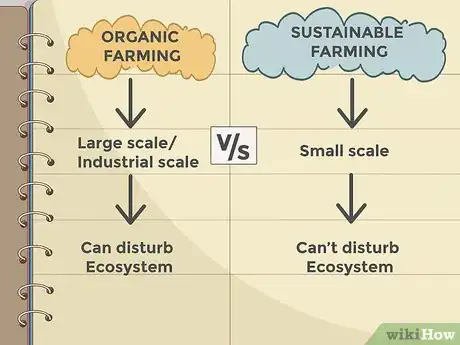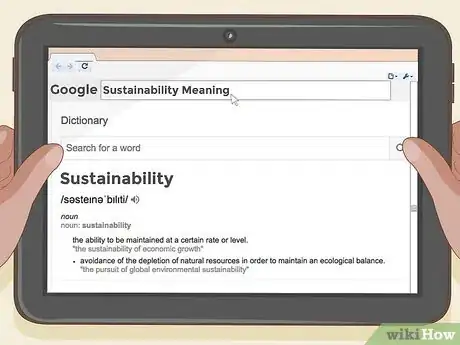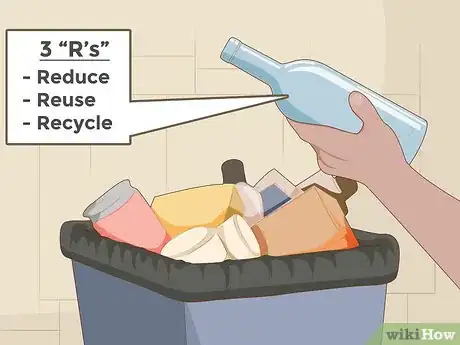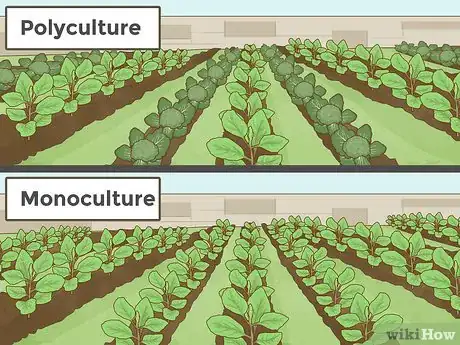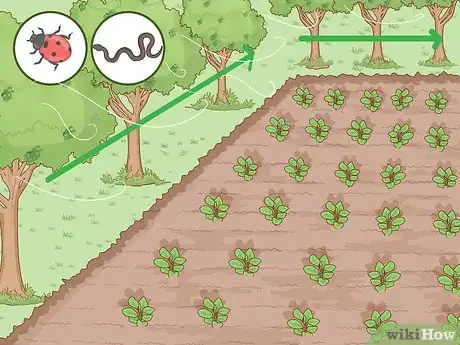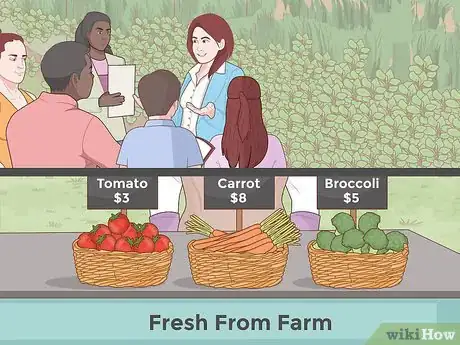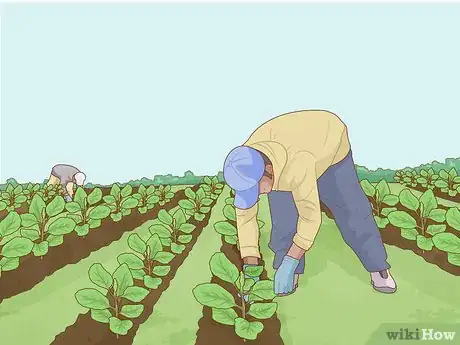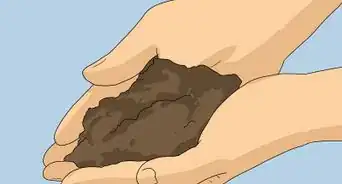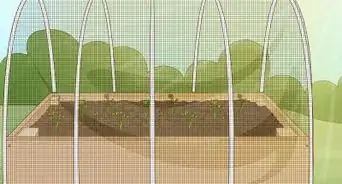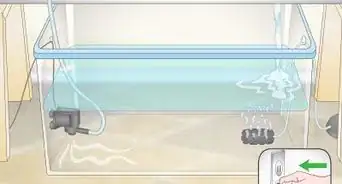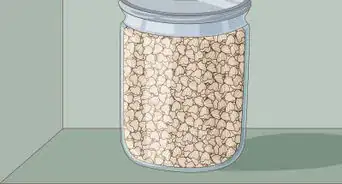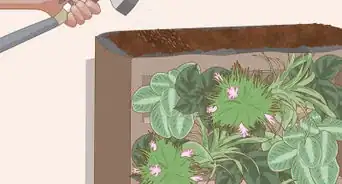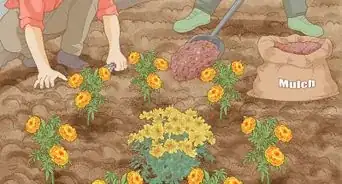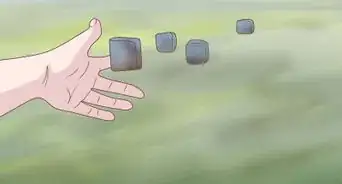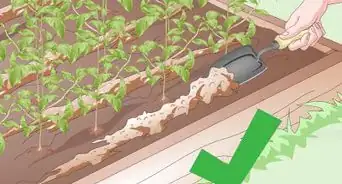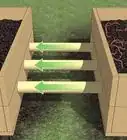wikiHow is a “wiki,” similar to Wikipedia, which means that many of our articles are co-written by multiple authors. To create this article, 33 people, some anonymous, worked to edit and improve it over time.
This article has been viewed 214,853 times.
Learn more...
If you want to farm sustainably, there are certain measures you need to undertake in order to move toward that goal. And if you're looking for a farm that practices sustainable methods, then you can use these steps as your criteria.
Steps
Designing Your Dream Farm
-
1Don't confuse "sustainable" with "organic". An organic label means that the food was grown or raised without the use of synthetic chemicals (but there are exceptions).[1]
- Lots of people confuse sustainable agriculture with organic farming. Both are aimed at using more ecologically sensible practices, but they are judged by a distinct set of standards.
- Organic farming, especially when carried out on a large, industrial scale, can still damage the environment and threaten public health in a variety of ways: Ecosystems can still be ruined by widespread monoculture; pesticides can still be applied; soils can still be depleted of nutrients and organic matter; pollution can still be created; and exorbitant amounts of fossil fuels can still be spent (and wasted), all under an organic label.
-
2Know what sustainability means: Farming a single area so that it produces food indefinitely. In order to move in this direction, a farm has to:[2]
- avoid irreversible changes to the land (for example, erosion)
- withdraw no resources from the environment that cannot be replenished (for example, not using more water than can be replaced regularly by rainfall)
- produce enough income to remain on a farm in face of worldwide farm consolidation and infrastructure development
Advertisement -
3Consider the source. Determine where your resources come from and whether you're taking more than can be replaced, either through natural processes or your own practices.
- Where are your resources and inputs coming from? Think specifically about water, energy, soil amendments, and feed (if you have livestock). Also think about long-term, capital investments, such as structural building materials, tools, etc.
- Keep in mind that no farm is an island: complete self-sufficiency is not a requirement of sustainable agriculture. Long-term stability and productivity is. The more renewable and varied your resources are, the longer your farm will last.
Make Changes
-
1Eliminate waste. There is no "away" to "throw" to. Everything is connected. The three "R"s apply here more than ever: reduce, reuse, recycle. It'll not only be more sustainable, but it's cheaper, too.
- Examine every bit of garbage and waste that your operation produces and ask "What else can I do with this?"
- If you can't do anything to do with it, try to think of ways someone else in the community can use it. Be creative.
-
2Encourage diversity within the farm. Choosing "poly culture" over "monoculture" results in less waste and often, reduced fossil fuel consumption.[3]
- Use varieties and breeds that are well-adapted to the conditions in your locale, rather than bred for maximum productivity and storage (with a sacrifice in hardiness and flavor).
- Rotate crops and pasture. Use companion planting and green manures to keep the land perpetually fertile and to prevent topsoil loss. Don't let any one piece of land lose an irreplaceable amount of nutrients.
- Keep plants and animals around that indirectly benefit the farm's stability and productivity. For example, yarrow and nettles add to the nutritional value of plants grown near them, as well as increase the volatile oil content of plants grown for oils. Plant extra basil to serve as an insecticide, and keep guinea fowl around to keep ticks at bay. As they roam your farm (and the surrounding countryside), guineas eat the ticks left by browsing deer off tall grasses. They are traditionally reputed to kill or keep rattlesnakes away as well.
- If guinea fowls are not common to your area, try growing ducks (if you have a fish pond) and/or chickens. Chickens can eat crop trimmings and vegetable waste. If they can't eat them all, they claw and step on it, enough to make it into organic fertilizers rich in nitrogen (especially when added to their poop).
- Raise both livestock and crops, and set up a mutually beneficial relationship between them. The simplest way to do this is to use manure from your livestock to fertilize crops, and use some of your crops to feed the livestock. If you are unable to raise both, find a neighbor who's specializing in the opposite and set up an exchange.
-
3Encourage the diversity surrounding the farm. The ecology of your farm does not end at the property lines.[4]
- Plant trees around the farm that act as windbreaks and also provide habitat for local birds (which can prey on insects that prey on crops).
- Tolerate natural predators that keep pests at bay (for example, snakes that feed on gophers, ladybugs that feed on aphids, spiders that feed on insects which spread diseases to crops).
-
4Diversify financially. An ecologically sustainable farming operation won't do anybody much good if it can't generate a profit and keep itself running. Unless you or someone else is willing and able to sponsor the farm with an off-farm day job or another external source of income, you're going to have to crunch the numbers until you're in the black.[5]
- Take advantage of the options available to you as far as direct marketing is concerned. That includes: CSA/subscriptions, farmers markets, roadside stands, and even the Internet.
- Adding value to products is a smart way to differentiate this farm's lettuce from that farm's lettuce. When you take your lettuce and make it part of delicious burger made from healthy meat that was pasture-raised in your own fields and top it with a slice of tasty, red tomato that grew in your own soil, you stand to appeal to a wider audience and rake in more profits. In other words, don't just grow a wider variety of stuff––do a wider variety of things with the stuff you grow, and consider selling it from an on-farm store or restaurant (as well as on the Internet).
- Cater to every economic level and ethnic group in the community. People of varying wealth seek different things from a farm. Certain ethnic groups value farm products that the mainstream community has no interest in (for example, many Caribbean immigrants seek male, uncastrated goats for meat as well as amaranth, a widespread weed, which they use to make a dish called Callaloo).
- Publicize. Talk to everyone about what you're doing at the farm. Provide educational tours and workshops. Keep your farm looking nice, because if it ever comes down to it, the local community may fight development proposals because they perceive your farm to be a haven of agricultural heritage.
-
5Find good, reliable labor. Find people who are committed to sustainable agriculture (not just dabbling in it) and who aren't afraid to get their hands dirty as they apply their minds.
- A reduced dependence on fossil fuels means an increased dependence on human labor, and not just physical, manual labor––you're going to need knowledgeable workers who understand the complexity of the system you're running and can enhance it with every decision they make.
-
6Enjoy your life. Farming is hard work, but the most successful farmers know when to call it a day and circumvent burnout. Remember why you're farming and why, in particular, you're aiming for a sustainable operation. For most people, it's because they like knowing they're leaving land in better shape than they found it.
Community Q&A
-
QuestionCan you explain crop rotation?
 DonaganTop AnswererIt is the practice of moving a given crop from one field to another (or from one area of a garden to another) from year to year. The idea is that each crop uses and affects soil differently, so that it is better for any area of soil to be planted with a different crop from one year to the next. Crop rotation is usually conducted over a three-year (or longer) period.
DonaganTop AnswererIt is the practice of moving a given crop from one field to another (or from one area of a garden to another) from year to year. The idea is that each crop uses and affects soil differently, so that it is better for any area of soil to be planted with a different crop from one year to the next. Crop rotation is usually conducted over a three-year (or longer) period. -
QuestionWhy should we practice sustainable farming?
 DonaganTop AnswererSo that we don't run out of natural resources in the future.
DonaganTop AnswererSo that we don't run out of natural resources in the future. -
QuestionWhat is the relationship between global warming, soil erosion and desertification?
 Shibesh DhunganaCommunity AnswerGlobal warming can bring a series of changes that cause soil erosion and desertification. Due to global warming, problems like irregular rainfall and drought can occur. These can contribute to soil erosion and desertification in the future.
Shibesh DhunganaCommunity AnswerGlobal warming can bring a series of changes that cause soil erosion and desertification. Due to global warming, problems like irregular rainfall and drought can occur. These can contribute to soil erosion and desertification in the future.
References
- ↑ https://www.ucsusa.org/resources/what-sustainable-agriculture
- ↑ https://asi.ucdavis.edu/programs/ucsarep/about/what-is-sustainable-agriculture
- ↑ https://www.ucsusa.org/resources/what-sustainable-agriculture
- ↑ https://attra.ncat.org/viewhtml/?id=295
- ↑ https://attra.ncat.org/viewhtml/?id=295
- http://en.wikipedia.org/wiki/Sustainable_agriculture Wikipedia on Sustainable Agriculture - Source of further information added to this article.
About This Article
To practice sustainable agriculture, make sure your farm does not use more resources, like water, than can naturally be replenished. To avoid overusing water, plant indigenous plants and plants that are well-suited to your climate. Sustainability also means ensuring that you don't irreversibly damage the ecosystem. To prevent topsoil loss, for example, rotate your crops and practice companion planting. In addition, composting and reusing materials are good ways to reduce your eco-footprint. For tips about creating a polyculture on your farm, keep reading!
